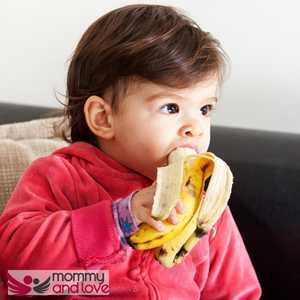When it comes to weaning your baby, there are a lot of different methods to choose from. Some parents opt for purees, while others go for baby-led weaning. This is where you allow your baby to feed themselves solid foods starting at around 6 months old.
One of the most important things when doing baby-led weaning is making sure that the food is cut into small pieces that are easy for your baby to pick up and chew on.
In this blog post, we will show you how to cut a banana so that it is perfect for baby-led weaning!
Are Bananas Healthy Food for Babies?

Yes, bananas are healthy food for babies! They are packed with nutrients like potassium and vitamins C and B-six. Bananas are also a great source of fiber.
One thing to keep in mind, however, is that bananas can be a choking hazard for babies. This is why it is so important to make sure that they are cut into small pieces before giving them to your baby.
What Are the Vitamins and Minerals Found in Bananas?
Serving bananas with baby food are a good source of several vitamins and minerals, including:
- Potassium – This mineral is important for maintaining healthy blood pressure and heart function.
- Vitamin C – This vitamin is important for immune system function and tissue repair.
- Vitamin B6 – This vitamin is important for brain development.
- Fiber – This nutrient is important for digestive health.
When can babies eat bananas?
Many parents wonder when their baby can start enjoying bananas. Bananas are a great first food for babies because they are easy to digest and full of nutrients. Most babies can start eating bananas at around six months old. You can give your baby banana slices or mashed banana.
If your baby is having trouble chewing, you can try a pureed banana or a banana smoothie. You can also serve bananas with little baby cereal or oatmeal. You can also serve them with banana puree. Another good pairing is nut butter. With bread they make a great banana sandwich or mix with pears and peaches for a delicious fruit salad.
How Often Can You Feed Your Baby Bananas?

So, how many bananas can a baby eat? The answer to this question may vary depending on the age of the child.
For example, a younger child may be able to eat more bananas than an older child. However, there are some general guidelines that can help you determine how much banana your child can eat safely each day.
Most children between the ages of two and four can safely eat one to two bananas per day. Older children and adults can safely consume two to three bananas per day. If your child is eating more than this, you may want to talk to their doctor to make sure they are getting enough other nutrients in their diet.
Are Bananas a Common Choking Hazard for Babies?
Yes, bananas can be a choking hazard for babies. This is why it is so important to serve bananas by cutting them into small pieces. You can also mash the banana before giving it to your baby to help reduce the risk of choking.
Are Bananas a Common Allergen?
The simple answer is no. And although there are reports of banana causing allergic reactions, these cases are extremely rare. While the exact prevalence of banana allergy is unknown, it is thought to be quite rare.
There are a few different ways that someone could be allergic to banana. The most likely way is through cross-reactivity. This means that the person is actually allergic to another food, such as latex, and not bananas specifically. However, there have been reports of people being allergic to the actual banana fruit itself.
If you think you may be allergic to bananas, don’t serve banana to your baby until you see an allergist for proper testing. An allergy to bananas can be life-threatening, so it is important to get a correct diagnosis. With proper treatment, most people with banana allergies can safely eat bananas and enjoy them as part of a healthy diet.
Symptoms of an allergy to bananas can range from mild ( itching and hives ) to severe ( anaphylaxis). If you experience any symptoms after you serve banana to your baby, it is important to seek medical attention immediately. An allergist can determine if you are truly allergic to bananas and develop a treatment plan to keep you safe.
Do Bananas Cause Constipation?
The answer may surprise you. While it is true that bananas contain dietary fiber, which can help promote regularity, they also contain a type of starch that can actually contribute to constipation. This starch is called resistant starch, and it’s found in both unripe and ripe bananas.
When consumed, resistant starch resists digestion and remains in the large intestine, where it can act as a food source for gut bacteria. However, this fermentation process can also lead to gas and bloating. So if you’re struggling with constipation, you might want to limit your banana intake, especially unripe bananas and green bananas, or opt for another type of fruit altogether.
Simple Banana Recipe for Babies
Ingredients:
- One whole banana (ripe banana)
- A tablespoon of unsweetened yogurt
- A pinch of ground cinnamon (optional)
Instructions:
Peel the banana and mash the peeled banana with a fork. Mix in the yogurt (or add some breast milk in there) and cinnamon. Serve immediately or store the mashed bananas in a covered container in the fridge for up to 24 hours.
There are many other simple and healthy banana recipes that even the busiest parents can make for their little ones. And, since it only uses a few ingredients that you probably already have on hand, it’s perfect for when you’re short on time or money. Plus, banana chunks are a great source of nutrients like potassium and fiber.
It also pairs well with other fruits such as blueberries, papaya and pineapple.
How to Cut a Banana for Baby-Led Weaning
When it comes to baby-led weaning, there are a few things you need to take into consideration when cutting up fruits and vegetables for your little one. The most popular way to prepare bananas is by making banana spears.
First of all, you want to make sure that the pieces are small enough for your baby to pick up and eat on their own. Secondly, you want to avoid any choking hazards.
One fruit that is perfect for baby-led weaning is the banana. Bananas are soft and easy to eat, making them a great first food for your baby. Plus, they are packed with nutrients like potassium. Here’s how to cut a banana for baby-led weaning:
Remove just the peel. Then, cut bananas in half lengthwise. Next, cut each half of the banana into thirds or fourths or make banana spears. Be sure to remove any brown spots or bruises before giving the pieces to your baby. Splitting banana into small bite-sized pieces are good for self-feeding.
Now that you know how to cut a banana for baby-led weaning, get creative and add them to other foods like oatmeal or pureed vegetables. Your baby will love the taste of bananas and you’ll be providing them with essential nutrients they need to grow and develop.
Conclusion
Bananas are healthy and delicious finger foods that can be enjoyed by both children and adults. When it comes to baby-led weaning, bananas are an excellent first finger food because they are soft and easy to eat. Plus, they are packed with essential nutrients like potassium.
When feeding bananas to your child, be sure to cut them into small pieces as finger food to avoid any choking hazards. Remember that less ripe bananas can cause constipation. And, if you’re not sure how much banana your child can eat safely each day, talk to their doctor or health professional for professional medical advice.

This article was written by Sandra Baker – full time writer and the mother of four amazing kids (including twins!)
She’s also a breastfeeding counselor and has spent years helping new parents learn how to care for their children. When she’s not writing or caring for her children, Sandra likes to spend time reading and taking walks with her husband.




